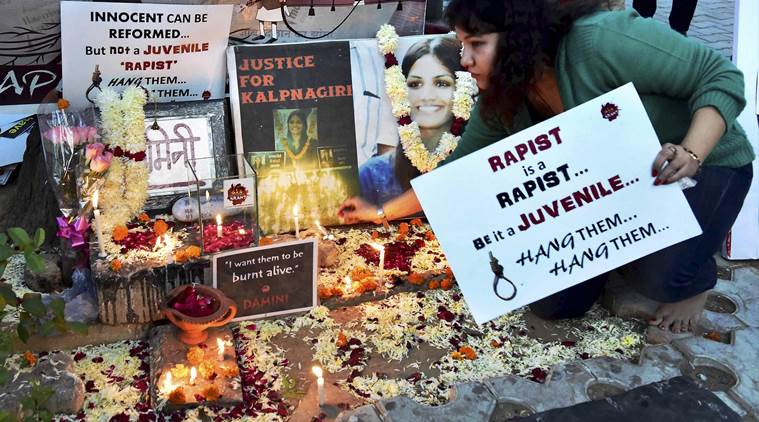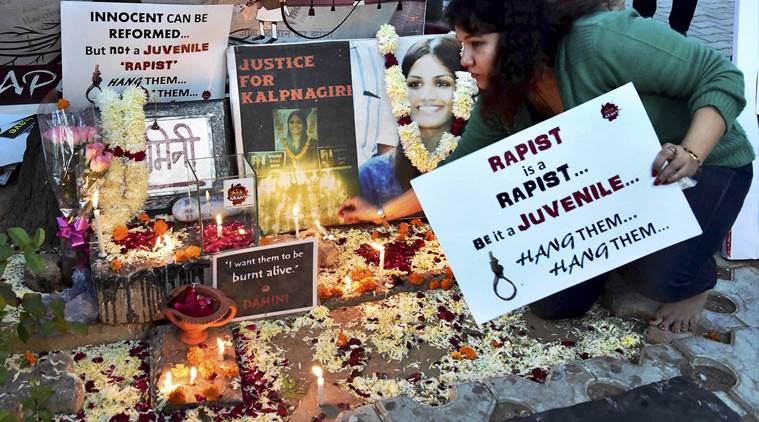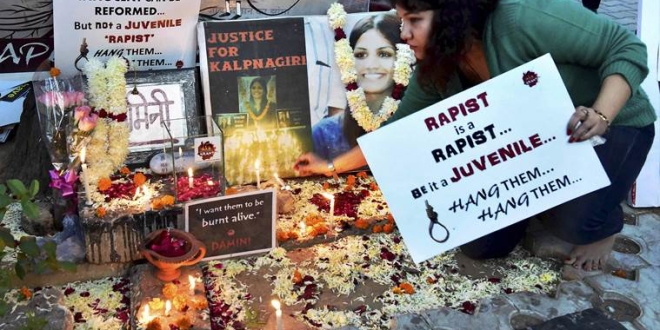
 New Delhi : A protester lights candles at a temporary shrine dedicated to the victim of a fatal gang rape of 2012 during a protest against the release of one of the convicts in New Delhi on Monday. (Source: PTI)
New Delhi : A protester lights candles at a temporary shrine dedicated to the victim of a fatal gang rape of 2012 during a protest against the release of one of the convicts in New Delhi on Monday. (Source: PTI)
I believe that the Nirbhaya debate in Parliament has missed a crucial point about the constitutional infirmity in both the unamended law and the amended one.
The fundamental premise of the juvenile law is that a person who lacks the mental maturity and understanding to know the nature and consequences of his actions should not be sent to a criminal court to be tried for the commission of an offence. Instead, he should be sent to a correctional home for reform and rehabilitation. Conversely, therefore, should the offender have the mental maturity and understanding to know the nature and consequences of his actions, he must be prosecuted before the criminal court, tried and, if found guilty, punished.
The unamended juvenile law placed a blanket ban on the power of the criminal court to try, and punish, a person below the age of 18 years for committing any offence, even where that person had the maturity and understanding to know the nature and consequences of his actions. In other words, a person below the age of 18 years could commit any offence he wanted, however heinous, without fear of being prosecuted, tried or punished. A person who is capable of committing rape, sodomy, inhuman torture and murder surely had the mental capacity to know the nature of his actions and the consequences of his actions, even where his age was less than 18. However, he would, at best, have been subjected to a child-friendly inquiry by a Juvenile Justice Board (as distinct from a court in terms of function, character and composition) and kept for a maximum period of three years in a correctional home. Such a state of affairs, on the face of it, was ridiculous and defied commonsense.
The Constitution differentiates among the functions of the executive, the legislature and the judiciary. It falls within the domain of judicial function to try a person committing a penal offence, complete with judicial discretion regarding the award of sentence keeping in mind, among other factors, the nature and gravity of the offence. It is well-settled that the assessment of whether or not an offender has attained sufficient maturity of understanding to judge the nature and consequences of his conduct is to be done by the court with the help of experts, and is a judicial function as exemplified by Indian substantive and procedural laws. There are precedents in which the Supreme Court has held that Parliament cannot make law to oust the judicial function of courts or even judicial discretion on a matter falling within the judicial function of courts. Thus, the unamended juvenile law, to the extent it deprived the criminal court of the power to try and punish a person below the age of 18 years for committing an offence, when such person could be assessed to have the maturity and understanding to know the nature and consequences of his action, was unconstitutional.
The uproar on the streets had spurred the government to propose an amendment to the juvenile law, which in effect sought to confer power upon the board to send a juvenile above the age of 16 to trial for the commission of a heinous offence. Such amendment, now passed by Parliament, suffers from the same defect as the unamended law. It would now protect an offender under 16 years, instead of 18 years, from being tried by the criminal court, even where such an offender has the maturity and understanding to know the nature and consequences of his actions. It has been consistently overlooked that the correct yardstick is the mental capacity of the offender — and not only his age. Studies indicate varying mental development of persons, with some claiming that the mind of certain individuals may not develop even till the age of 21 years. Age, though relevant, cannot be the decisive yardstick. Further, the amended law, to the extent it confers power on the board, and not the court, to assess the mental capacity of an offender between the ages of 16 to 18 years again suffers from the same vice of ousting judicial discretion.
It may be noted that the Supreme Court, in its judgment of March 28, 2014, upheld the constitutional validity of the unamended juvenile law by taking the view that it merely introduced “a different scheme for trial and punishment” for dealing with errant juveniles. Such finding ran contrary to the observation of the Supreme Court at another place in the same judgment that the board conducts a non-adversarial “inquiry” (as opposed to a trial) with the aim of reforming and rehabilitating the errant juvenile (as opposed to punishing him). As such, the court failed to address the constitutional defects noted above. The decision thus needs reconsideration.
While the juvenile law did need to be amended to cure the constitutional infirmity, the amended law will result in the same injustice as has been meted out to Nirbhaya and other sufferers, including minor victims of juvenile offenders. Many persons would, under the amended law, walk away free without any penal consequences after committing horrendous offences, as in Nirbhaya’s case, on the specious plea that they are below 16. It will only be a matter of time when we find ourselves again at this juncture.
![]()
Source: New feed






